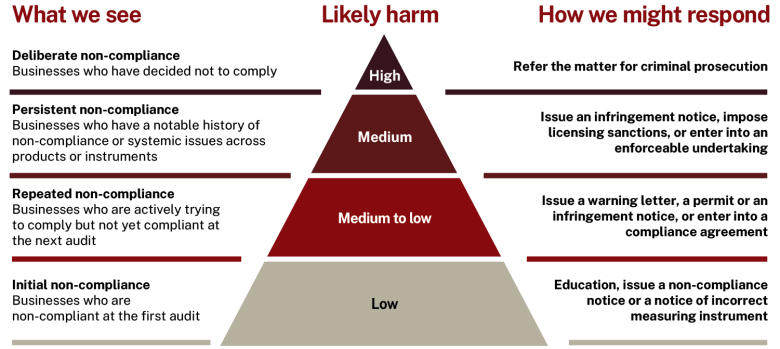Why compliance matters
Australia’s measurement system ensures that goods being sold are measured correctly. Compliance with Australia’s measurement laws helps build a trusted measurement system for Australia that:
- supports consumers and businesses to make informed decisions when they buy something, so they ‘get what they have paid for’
- ensures a level playing field for businesses in Australia
- limits financial harm to consumers and businesses.
Australia’s measurement laws are the National Measurement Act 1960, the National Measurement Regulations 1999 and the National Trade Measurement Regulations 2009.
How we identify non-compliance
Our trade measurement inspectors visit businesses to check that they comply with Australia’s measurement laws. The visit could be a targeted audit that is part of our national compliance program, or it can be in a response to a complaint.
We find that most businesses want to comply with Australia’s measurement laws. When businesses don’t comply with those laws, one of our responsibilities is to change their behaviour.
Responses to non-compliance
We will respond when a business doesn’t comply with Australia’s measurement laws. Our response depends on the circumstances. Our aim is to deter future non-compliance without creating unnecessary burdens on business.
If we find non-compliance when we audit a business, we may issue:
- a non-compliance notice – confirms the non-compliance in writing. When we follow up, most businesses will have fixed the problem
- a notice of incorrect measuring instrument – instructs the business to not use a measuring instrument until it is fixed and re-verified (checked for accuracy). If the fault doesn’t cause harm, we may let the trader keep using the instrument if they fix it within a given time.
Our trade measurement inspectors tell business what they find before they leave. We see this as an important part of helping business understand what they need to do to comply with Australia’s measurement laws.
For prepackaged goods, businesses may ask for a permit to allow the importation or sale of prepackaged goods that contain minor labelling non-compliances that do not mislead.
Serious, repeated or deliberate non-compliance may result in one of the following responses:
| Response | What it looks like |
|---|---|
| Warning letter |
When we find repeated minor non-compliance, but it doesn’t cause significant harm, we will formally warn a business that it:
|
| Infringement notice |
We may issue an infringement notice when:
It imposes a fine under strict liability criminal offence provisions in measurement law. More serious or repeated offences attract larger fines. If the business doesn’t pay the fine or the behaviour continues, we may pursue it through the courts. |
| Compliance agreement |
We may negotiate a compliance agreement when:
|
| Enforceable undertaking |
We may negotiate an enforceable undertaking in response to systemic non-compliance when:
If the business doesn’t meet the terms of the undertaking, we may pursue it through the courts. |
| Prosecution |
We may refer serious non-compliance to the Commonwealth Director of Public Prosecution. We take this action when we consider it is in the public interest to go to court and:
|
How we decide our response
Most businesses try to do the right thing, and a written non-compliance notice is enough to help them identify and fix the problem. Serious, repeated, or deliberate non-compliance attracts a higher level response.
When deciding our response to non-compliance, we follow these 3 principles:
- Transparency – we explain to businesses the reasons for our decision when we find non-compliance.
- Consistency – we are consistent in the way we interpret, apply and enforce Australia’s measurement law.
- Proportionality – we ensure our response fits the severity of the non-compliance.
In practical terms, we consider the:
- nature of the non-compliance – is it an isolated incident or systemic?
- consequence of the non-compliance – how much harm is likely?
- compliance history of the business – is this the first time we have found non-compliance?
- businesses efforts to comply – is the management actively involved in the solution? how effective are any quality assurance processes that are in place?
- culpability of the business – was the non-compliance intentional, reckless or negligent?

